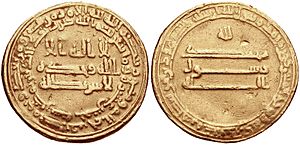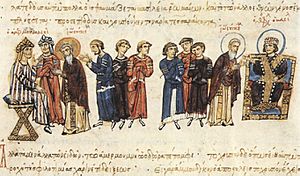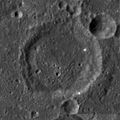- This page was last modified on 17 October 2025, at 10:18. Suggest an edit.
al-Ma'mun facts for kids
This page is about an Abbasid caliph. For other uses, see Al-Ma'mun (disambiguation).
| al-Ma'mun المأمون |
|||||
|---|---|---|---|---|---|
| Caliph Commander of the Faithful |
|||||

Gold dinar of al-Ma'mun, minted in Egypt in 830/1
|
|||||
| 7th Caliph of the Abbasid Caliphate | |||||
| Reign | 27 September 813 – 7 August 833 | ||||
| Predecessor | al-Amin | ||||
| Successor | al-Mu'tasim | ||||
| Born | September 14, 786 Baghdad, Abbasid Caliphate |
||||
| Died | August 7, 833 (aged 46) Tarsus, Abbasid Caliphate, now Mersin Province, Turkey |
||||
| Burial | Grand Mosque of Tarsus | ||||
| Consort |
|
||||
| Issue |
|
||||
|
|||||
| Dynasty | Abbasid | ||||
| Father | Harun al-Rashid | ||||
| Mother | Umm Abdallah Marajil | ||||
| Religion | Islam | ||||
Al-Ma'mun (born Abdallah ibn Harun al-Rashid on September 14, 786 CE) was the seventh Abbasid caliph, or ruler, of the Islamic Empire. He ruled from 813 until his death in 833 CE.
Al-Ma'mun became caliph after a civil war with his half-brother, al-Amin. This war made the Abbasid Empire weaker, with many local rebellions. Al-Ma'mun spent much of his rule trying to bring peace back to the empire.
He was very interested in learning and helped start the Translation Movement. This was a time when many important books from ancient Greece were translated into Arabic. He also supported the House of Wisdom in Baghdad, which became a center for science and learning. During his time, the famous book on algebra by al-Khwarizmi was published. Al-Ma'mun also restarted large-scale wars with the Byzantine Empire.
Contents
Early Life and Learning
Abdallah, who would later be known as al-Ma'mun, was born in Baghdad in 786 CE. His father was Harun al-Rashid, who became caliph on the same night Abdallah was born. His mother, Marajil, passed away soon after his birth.
Abdallah was raised by his father's wife, Zubayda. She came from a very important Abbasid family. As a young prince, Abdallah received an excellent education. He learned classical Arabic, literature, music, and poetry. He also studied Islamic law and the sayings of the Prophet Muhammad. People said he loved knowledge very much, which made him a very smart ruler.
Becoming a Successor
Even though Abdallah was the oldest son, his father Harun al-Rashid first named his second son, Muhammad, as the main heir in 794 CE. This was because Muhammad's mother was from the Abbasid royal family. Muhammad was given the name al-Amin, meaning "The Trustworthy."
Abdallah was named the second heir in 799 CE, receiving the name al-Ma'mun, meaning "The Trusted One." He was also made the governor of Khurasan, a very important region in the eastern part of the empire. Khurasan was where the Abbasid family first came to power.
In 802 CE, these plans were made public. Al-Amin would rule from Baghdad, and al-Ma'mun would rule Khurasan with a lot of freedom. This arrangement led to rivalry between the brothers.
The Civil War Begins
After their father Harun al-Rashid died in 809 CE, the relationship between al-Amin and al-Ma'mun got worse. Harun had wanted al-Ma'mun to become caliph after al-Amin. However, al-Amin declared his own son as his heir, breaking his father's wishes.
This led to a big fight for power. Al-Amin gathered a large army in Baghdad in 811 CE and sent it to Khurasan. But al-Ma'mun's general, Tahir ibn al-Husayn, defeated al-Amin's army. Tahir then marched into Iraq and surrounded Baghdad in 812 CE.
In 813 CE, Baghdad fell. Al-Amin was killed, and al-Ma'mun became the undisputed Caliph.
Challenges During His Rule
After becoming caliph, al-Ma'mun stayed in Merv for several years. During this time, there were many problems and rebellions in Iraq.
- Rebellions in Baghdad: People in Baghdad were unhappy with the lawlessness. They formed groups to keep order. Two important leaders of these groups were Khalid al-Daryush and Sahl ibn Salama al-Ansari. Their movement grew strong, but eventually, military leaders worked together to stop them.
- Imam al-Rida: In 817 CE, al-Ma'mun named Ali ar-Rida, a respected religious leader, as his heir. This might have been to make the Shi'ite people in Iraq happy. However, in Baghdad, some powerful families and military leaders did not like this. They removed al-Ma'mun from power and chose his uncle, Ibrahim ibn al-Mahdi, as caliph instead.
- Return to Baghdad: To deal with the rebellion, al-Ma'mun headed to Baghdad in 818 CE. On his journey, his chief minister, Fazl ibn Sahl, was killed. Soon after, Imam al-Rida also died. Some historians believe al-Ma'mun might have been involved in their deaths to make it easier to regain control in Baghdad. Al-Ma'mun showed great sadness at Imam al-Rida's funeral and had him buried next to his own father.
- Restoring Order: Al-Ma'mun finally entered Baghdad in 819 CE. He changed the official color of the Abbasid court from green back to black to show he was following tradition. He then sent his generals to put down other uprisings across the empire, including in Egypt, Qum, Yemen, and Sindh. A major ongoing challenge was the revolt led by Babak Khorramdin.
Wars with the Byzantine Empire
When al-Ma'mun became caliph, the wars between the Arabs and the Byzantine Empire were mostly small border fights. However, this changed around 820 CE.
- Crete and Sicily: The Byzantines were busy fighting a rebel leader, which allowed Arab forces to capture the island of Crete in 824 CE. In 827 CE, Arabs from Tunis also invaded Sicily. Even though the Byzantines fought hard, the Arabs eventually took Palermo in 830 CE.
- Campaigns in Anatolia: Al-Ma'mun himself led invasions into Anatolia (modern-day Turkey) in 830 CE. His forces captured many Byzantine forts. The Byzantine Emperor, Theophilos, also captured Tarsus in 831 CE. The next year, al-Ma'mun returned and captured even more forts.
- Peace and Knowledge: Theophilos wrote to al-Ma'mun, who offered him choices: accept Islam, pay a special tax, or continue fighting. Al-Ma'mun was preparing for a huge campaign when he died. Interestingly, al-Ma'mun's interactions with the Byzantines also involved a quest for knowledge. He asked the Byzantine Emperor to send him famous Greek manuscripts, especially Ptolemy's Almagest, an important book on astronomy. These were then translated into Arabic.
Al-Ma'mun's Achievements
Al-Ma'mun's reign is known for his great interest in learning and science.
- The House of Wisdom: He established the Bayt al-Hikma, or House of Wisdom, in Baghdad. This was a major center for learning, where scholars from different religions gathered. They translated ancient Greek and other texts into Arabic. This work helped preserve many important ideas and led to a "golden age" of Islamic science and philosophy.
- Astronomy and Cartography: Al-Ma'mun supported astronomers who measured the Earth's size. A crater on the Moon, Almanon, is named after him because of his contributions to astronomy. He also asked astronomers and geographers to create a world map. This map showed large parts of Asia, Europe, and Africa, and was much more detailed than earlier maps of the oceans.
- Alchemy: During his rule, the study of alchemy (an early form of chemistry) grew. Scientists like Jabir Ibn Hayyan were supported by al-Ma'mun. Their work, though not always successful in turning metals into gold, helped develop new medicines.
- Centralizing Power: Al-Ma'mun worked to make the caliph's power stronger. He tried to ensure that his chosen successor would take over smoothly.
Religious Views and Challenges
Al-Ma'mun had some unique religious views that caused debate. He was interested in Mu'tazilism, a way of thinking that used logic and reason to understand religious matters. This was different from traditional views that relied strictly on the literal meaning of the Qur'an and Hadith.
- The Mihna: In 833 CE, al-Ma'mun started a "test of faith" called the mihna. Important scholars, judges, and government officials had to answer questions about their beliefs. The main question was whether they believed the Qur'an was "created" by God, rather than being "coeternal" with God (meaning it always existed with God). If they said it was created, they could continue their work. This was a way for al-Ma'mun to try and centralize religious authority under the caliph.
- Opposition: Many traditional scholars, like Ahmad ibn Hanbal, strongly opposed the mihna. They believed the Qur'an was coeternal with God. This opposition grew, and the mihna eventually ended after al-Ma'mun's reign.
- Shia Relations: Al-Ma'mun tried to improve relations with Shi'ite Muslims. He named the eighth Imam, Ali ar-Rida, as his successor. However, many Shi'ites were suspicious, and Imam al-Rida died during al-Ma'mun's journey to Baghdad.
Death and Legacy
Al-Ma'mun died on August 9, 833 CE, near Tarsus. Stories say he fell ill after drinking river water with fresh dates. He encouraged his successor to be fair to the people.
He was not succeeded by his son, al-Abbas ibn al-Ma'mun, but by his half-brother, al-Mu'tasim. Al-Ma'mun's tomb is believed to be in the Grand Mosque of Tarsus. His reign is remembered as a time of great intellectual growth and scientific discovery in the Islamic world.
Images for kids
-
Silver Dirham of al-Ma'mun. AH 199-218 / AD 813–833.
-
Abbasid Caliph al-Ma'mun sends an envoy to Theophilos
See also
 In Spanish: Al-Mamún (califa) para niños
In Spanish: Al-Mamún (califa) para niños






